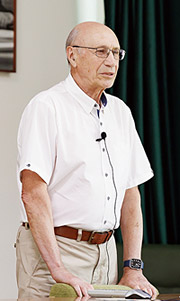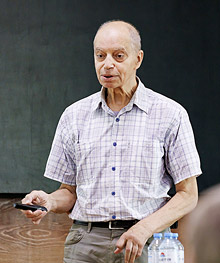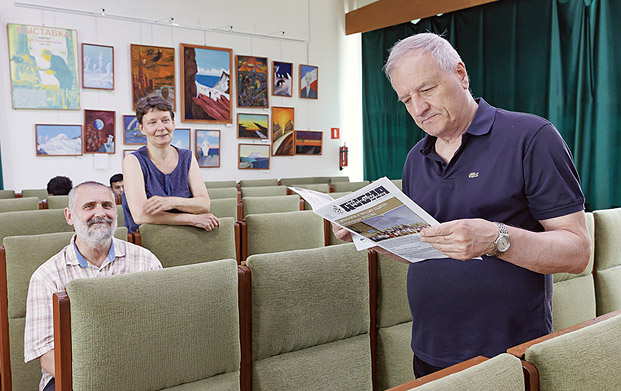
Electronic english version since 2022 |
The newspaper was founded in November 1957
| |
|
Number 23 (4721) |
Their names are in the history of the Institute
Continuing the dialogue with Nikolay Maksimilianovich
On 6 June, a seminar in memory of Professor N.M.Plakida was held in the Blokhintsev auditorium of BLTP. The Seminar brought together employees of BLTP, FLNP and MLIT.
 |
| Viktor Aksenov |
"Nikolay Maximilianovich worked on many scientific problems, but in the scientific world he is widely known for two main results - theories of anharmonic crystals and superconductivity," Viktor Lazarevich emphasized. The speaker also contributed to the construction of the anharmonic prototype together with Bogolyubov and Plakida. In 1966, work started on the IBR-2 project and a couple of years later, the discussion turned to developing a scientific programme for the reactor. "In V.G.Solovev's department, where we worked at the time, an annual report was held, at which each employee had to report on what he had done that year for IBR-2," V.L.Aksenov recalled. The cooperation between BLTP and FLNP continued that we saw with our own eyes - photographs of theorists' visits to the experimental facilities of FLNP that were being developed and operating were shown at the seminar.
The discovery of high-temperature superconductivity (HTSC) in 1986 caused an explosion of activity among theorists. Viktor Lazarevich said that N.M.Plakida that began scientific research with superconductivity said that his time had come. Many basic concepts of the theory were laid down by N.N.Bogolyubov in his fundamental papers on statistical mechanics and superconductivity. "Our joint articles with Nikolay Nikolaevich and N.M.Plakida in 1988-1990," V.L.Aksenov noted, "were based on these papers with the addition of the mechanism of structural instability."
The next stage began after a compound was synthesized in 1993 in the laboratory of E.V.Antipov that was participating in the seminar, at Moscow State University that allowed the temperature of high-temperature superconductors to be raised to 150K. Research into the structural features of new superconductors began at IBR-2. Nikolay Maksimilianovich immersed himself entirely in this research that ended in success. V.L.Aksenov introduced to the audience Plakida's theory - the kinematic spin-fluctuation mechanism of high-temperature superconductors in systems with strong electron correlation.
The speaker described the pedagogical talent of his teacher as follows: "We traveled quite a lot - to conferences, schools and he was always eager to tell someone something. And the amazing thing is that people - not students, but professors - listened to him with bated breath; at any school he was followed by a tail of people wanting to gain knowledge. He was an outstanding teacher."
 |
| Viktor Yushankhay |
 |
| Anatoly Balagurov |
In the late 1990s, manganites with colossal magnetoresistance were discovered and many theorists and experimenters joined to studying this phenomenon. They also took up this at FLNP together with colleagues from the Kurchatov Institute that discovered the giant isotope effect in manganites. In conclusion, Anatoly Mikhailovich spoke about what he and his colleagues currently work on - alloys with the effect of giant magnetostriction. And he explained that he tried to involve Nikolay Maximilianovich in this phenomenon, but he was very busy with superconductors at that time.
 |
| Evgeny Antipov |
"Our cooperation with FLNP and theorists began about 30 years ago, communication with Plakida was quite interesting. But today, I want to talk about what we have been doing for the last 15 years and the goal of my speech is to organize more intensive cooperation in a new area," this is how E.V.Antipov (MSU, Skoltech) began his speech. In the report "Metal-ion batteries: problems and prospects" he outlined the state of affairs and prospects for the development of this industry.
V.D.Lakhno (Institute of Mathematical Problems of Biology, Russian Academy of Sciences) spoke about N.M.Plakida and the polaron theory. Since the early 1980s, he collaborated with colleagues at the Laboratory of Theoretical Physics and carried out calculations on the BESM 6 computer at the Leningrad Higher Technical Academy. "Nikolay Maksimilianovich was a super professor, but he did not study the classical polaron that we did. I can say that he was a leader in the investigation of high-temperature superconductors and his book is the best in this field, it is an encyclopedia on the physics of high-temperature superconductors. I approached to him with questions on the theory of strong coupling, we discussed them, I was preparing an answer for him, but he unexpectedly passed away. Polaron is a composite particle, these are fermions and bosons. Unfortunately, we will no longer be able to discuss this with Nikolay Maksimilianovich, but for me he lives in his books."

Viktor Lakhno (on the right)
Olga TARANTINA,
photo by Elena PUZYNINA